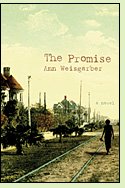The Promise
by Ann Weisgarber
Reviewed by Margaret Donsbach Tomlinson

The climax of The Promise comes with the massive Galveston hurricane of September 1900. The most deadly natural disaster ever to strike the United States, the storm left more than 6,000 people dead, flattened the city of Galveston, and permanently ended the city's status as Texas' most important seaport.
This novel imagines the lives of two women living on Galveston Island a few miles outside the city. Concert pianist Catherine Wainwright leaves Ohio after a disastrous scandal ends a love affair and drives her to accept a renewed proposal from Oscar Williams, the widowed dairy farmer who years ago asked her to marry him. Disoriented by shame and loss, shocked by the Texas heat and Galveston's rustic manners, Catherine struggles to keep her composure, an effort that makes her all the more awkward as Oscar's bride and as stepmother to his five-year-old son. Nan Ogden, a close friend of Oscar's first wife, has been keeping house for him and caring for his son, cherishing a hope that he would marry her once his grief faded. She resents Catherine's arrival, showing disdain for her lack of initiative and skill with domestic tasks, and irritation when Catherine does try to help with the housework.
The ominous signs of the impending hurricane are not well understood by the islanders, who have weathered milder storms by building their homes on stilts and trusting the "ridge" to shelter them. The storm tests all three characters, revealing unexpected strengths and weaknesses as tragedy descends. Despite the high drama of its storyline, The Promise is an understated novel told in clean, cool language. The characters feel thoroughly real; if this makes them less compellingly sympathetic than some readers might wish, it makes them all the more credible for readers looking for a believable story about one of history's deadliest storms. (2013; 309 pages, including an Author's Note about the history behind the story)
More about The Promise at Powell's Books, Amazon.comOther novels about natural disasters:
Pompeii by Robert Harris (2003), about a Roman engineer investigating a problem with one of the acqueducts that serves Pompeii on the eve of the disastrous eruption. More info
Locked Rooms by Laurie R. King (2005), a Sherlock Holmes mystery about a young woman who returns to San Francisco, where she grew up and experienced the devastating 1906 earthquake as a child; #8 in the Mary Russell mystery series. More info
Southern Cross the Dog by Bill Cheng (2013), about a young man who loses all he owns in the Great Mississippi Flood of 1927 and takes a job clearing swampland to build a dam, where he meets a family of fur trappers whose livelihood the dam will destroy. More info
Nonfiction about the Galveston hurricane of 1900:
Isaac's Storm by Erik Larson (1999). More info
Through a Night of Horrors, edited by Casey Edward Greene and Shelly Henley Kelly (2000). More info
Galveston and the 1900 Storm by Patricia Bellis Bixel and Elizabeth Hayes Turner (2000). More info
A Weekend in September by John Edward Weems (1957). More info
Online:
The 1900 Storm, a website devoted to the hurricane
Back to Twentieth Century America, Before the Wars
Back to Directory of Book Reviews